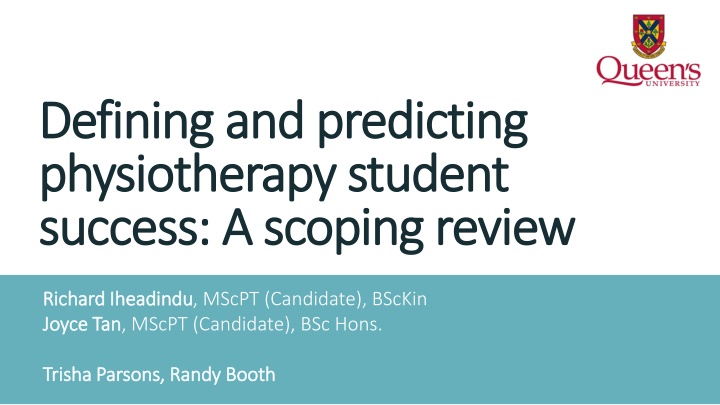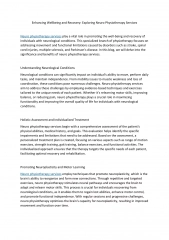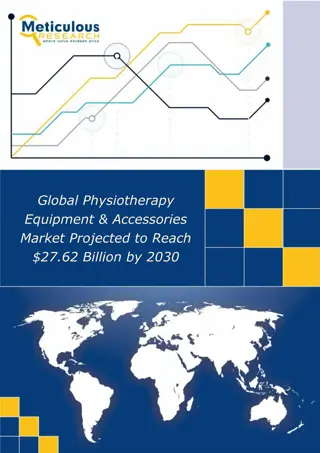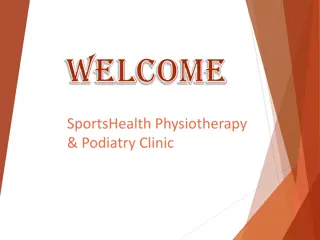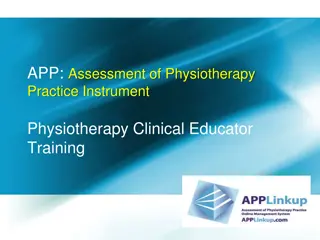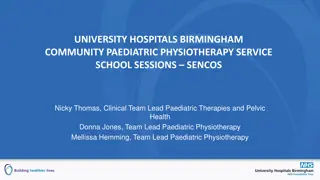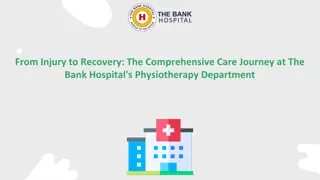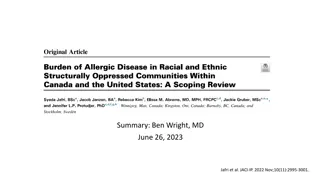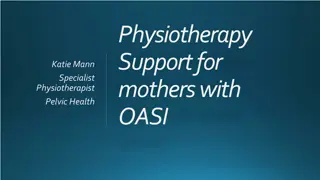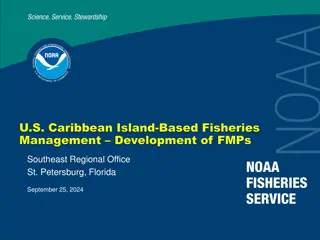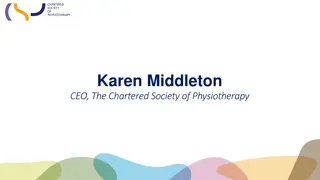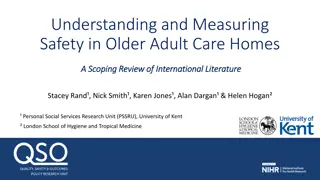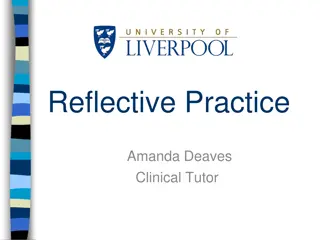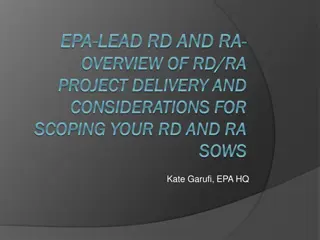Predicting Physiotherapy Student Success: A Scoping Review
This scoping review explores how physiotherapy student success is defined in the admissions process and identifies commonly used admission criteria through a thorough literature search. Understanding how to predict candidate success is vital for selecting competent physiotherapists to meet future healthcare needs. Various preadmission variables like GPA, personal statements, and interviews are examined to enhance the admissions process in physiotherapy programs.
Download Presentation

Please find below an Image/Link to download the presentation.
The content on the website is provided AS IS for your information and personal use only. It may not be sold, licensed, or shared on other websites without obtaining consent from the author.If you encounter any issues during the download, it is possible that the publisher has removed the file from their server.
You are allowed to download the files provided on this website for personal or commercial use, subject to the condition that they are used lawfully. All files are the property of their respective owners.
The content on the website is provided AS IS for your information and personal use only. It may not be sold, licensed, or shared on other websites without obtaining consent from the author.
E N D
Presentation Transcript
Defining and predicting Defining and predicting physiotherapy student physiotherapy student success: A scoping review success: A scoping review Richard Richard Iheadindu Iheadindu, MScPT (Candidate), BScKin Joyce Tan Joyce Tan, MScPT (Candidate), BSc Hons. Trisha Parsons, Randy Booth Trisha Parsons, Randy Booth
Purpose (1) (1) How physiotherapy student success was defined within the context of the admissions process (2) (2) The degree to which commonly used admissions criteria were identified in peer-reviewed study
Purpose Relevance to PT profession? Relevance to PT profession? Future of healthcare dependent on having competent physiotherapists Admissions must be able to select the candidates with greatest potential to succeed in the profession Why is it important for PT programs to understand how to best predict success of Why is it important for PT programs to understand how to best predict success of program candidate? program candidate? Vast amount of variabilities between each applicant Use evidence-based research to determine the most important criteria for admission, and to have a consensus on what student success is to guide this selection
Progress/Methods Structured Literature Search: Structured Literature Search: Population: variations on PTs, OTs, and health care professions +/- students Context: admissions, entrance exams, etc. 285 papers 285 papers across 3 databases (OVID, CINAHL, PsycINFO) De De- -duplication and Inclusion Criteria duplication and Inclusion Criteria Inclusion criteria Inclusion criteria Article type: Journal Article Population: Physiotherapy students/candidates Context: Admissions 37 journal articles 37 journal articles 12 journal articles 12 journal articles related to increasing minority applicants, funding, recruitment issues, and attitudes Screening for Relevance to Screening for Relevance to Purpose of Study Purpose of Study 25 journal articles 25 journal articles related to predicting physiotherapy student success
Progress/Methods Preadmission variables of interest Preadmission variables of interest Definitions of success Definitions of success GPA Personal Statement Educational Background Prerequisites Experience Interviews References Other Academic success/failure in school Passing/failing NPTE Clinical success Other No definition
Findings Academic Success 8 journal articles 8 journal articles defined PT student success as being academically successful in their final year of school (GPA), graduating, or having successful clinical marks/score GPA Educational Background Prerequisites Interviews Day, 1986 Edgar, Mercer, & Hamer, 2014 Morris & Farmer, 1999 Platt, Turocy, & McGlumphy, 2001 Ruscingo, Zipp, & Olson, 2010 Tousignant & Trottier, 1998 Tousignant & Trottier, 1998 Ruscingo, Zipp, & Olson, 2010 Edgar, Mercer, & Hamer, 2014 Other Day, 1986 Edgar, Mercer, & Hamer, 2014 Platt, Turocy, & McGlumphy, 2001 Tousignant & Trottier 1998
Findings- Risk of Failure/Failure 7 journal articles 7 journal articles defined PT student success as risk of academic failure, academic failure, or difficulty in the program leading to attrition Educational Background GPA Andrews, Johansson, Chinworth, & Akroyd, 2006 Utzman, Riddle, & Jewell, 2007 Wheeler & Arena 2009 Andrews, Johansson, Chinworth, & Akroyd, 2006 Green & Waterfield, 1997 Wheeler & Arena 2009 Interviews Other Gabard, Porzio, Oxford, & Braun, 1997 Lewis & Smith 2002 Jewell & Riddle 2005 Lewis & Smith 2002 Utzman, Riddle, & Jewell, 2007 Wheeler & Arena, 2009
Findings- Pass/Fail NPTE 4 journal articles 4 journal articles defined PT student success based on passing or failing the NPTE: Huhn & Parrott, 2017 Nayer, 1992 Utzman, Riddle, & Jewell, 2007 Hollman, Rindflesch, Youdas, Krause, Hellyer, & Kinlaw, 2008 Roehrig, 1988
Other Scattered variable studies Clinical scores/marks Payton, 1997 Edgar, Mercer, & Hamer, 2014 Clinical placement score Morris & Farmer, 1999 Edgar, Mercer, & Hamer, 2014 Others: Research project mark, average clinical patient assessment scores Morris & Farmer, 1999
Implications Current Summary of Results Current Summary of Results GPA is an important predictor of success Interviews should be used with caution Educational background pros/cons of having a Bachelor vs. Master/Doctoral program? Consider using other preadmission criteria should Canada begin to use GRE as a preadmission test for PT program? A combination of variables should be used for preadmission as no one variable is the best predictor
Next Steps Screen through the remaining journal articles to look for trends and results Write-up for publication
Acknowledgements Contact Information Contact Information Richard Iheadindu 16ri3@queensu.ca Joyce Tan joyce.tan@queensu.ca Trisha Parsons trisha.parsons@queensu.ca Randy Booth boothr@queensu.ca Gail Woodbury
